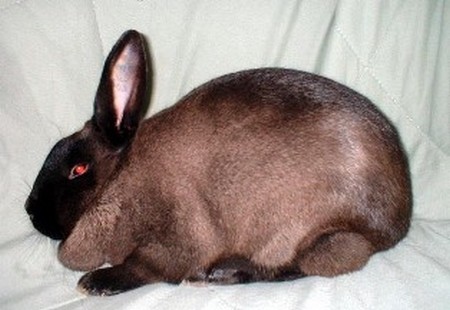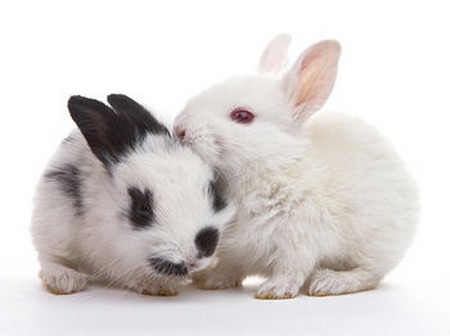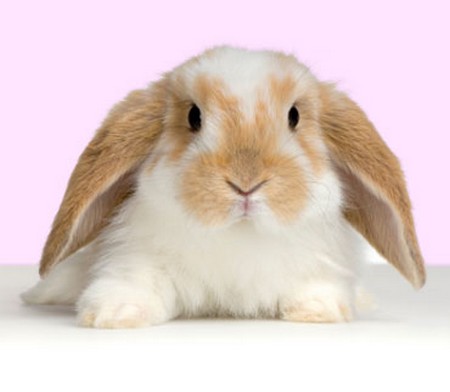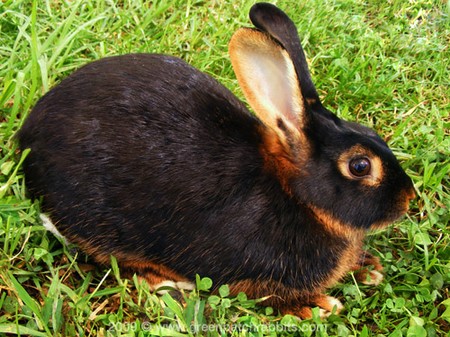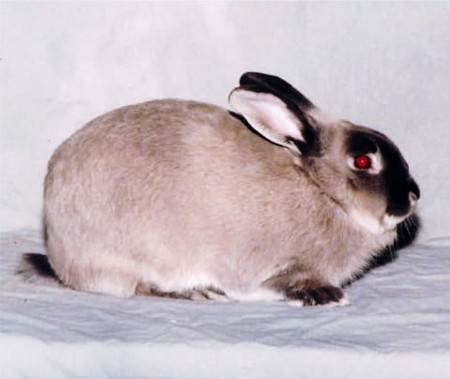Rabbits are known to be small mammals belong to the family Leporidae of the order Lagomorpha. Rabbits are often kept as pets and it really becomes difficult for you to choose the right type of rabbit that is perfect for your home settings. It is because so many different varieties of rabbits are found which are distinct in their characteristic features.
Different types of rabbits possess some distinctive features which one has to bear in mind while selecting a pet rabbit. You have to consider the size of adult rabbit, petulance, and other attributes related to their personality including activeness, curiosity and excitability. Following are given some of the different types of pet rabbits with brief description.
American Sable Rabbit
Sable rabbits are known to have two popular varieties, i.e. the Siamese and the Marten. Both the varieties are available in light, medium and Clark colors. Among the two, the Siamese is known to be a self rabbit that bears the factors for the Chinch inference, whereas the Marten Sable is a variety with tan pattern which is replaced by white. This variety also bears factors for Chinch inference. The Siamese and the Marten are known as shaded varieties. In the beginning, the occurrence of sables recorded in the offspring Chinchillas. At that time, these were not appreciated and removed but later they were kept and given the name Mara aka. The most occurred among them were the Marten Sables. The Siamese variety was found in the offspring of Marten. Today, they are known by the name Siamese cat, the Marten and the Wild Stone Marten.
Sables are usually found in the color range from rich sepia saddle shading to lighter sepia on the flanks and sides. However, the flanks and rump of the Marten contains long, white hairs. They are also white on the belly.
The fur of the Sables is of normal nature and of high quality. The sables have weight from 5-7 pounds.
Angora Rabbits
One of the oldest breed of pet rabbits is angora. They are known for the wool which they produced for over hundreds of years. Up till mid-1920s, the worlds’ major supply came from France, but later the Eastern European and Japanese became the major supplier. The English Angoras is known to have a much finer and smaller coat than other Continental partners but the production is not on higher side. The Angora variety is a breed of rabbit that require much more care and attention for its grooming to make certain that the coat of the angora doesn’t become matt. The Angora rabbit has an average weight of 6 pounds. The Angora rabbits are known to be found in twelve different colors, but white is the most common.
Belgian Hare
The Belgian Hare is a breed of rabbits which is known as a Fancy breed for quite a long time. It is widely kept for exhibition purposes. In past, it was also kept or grown for meat production. Hereditarily, it has a color similar to wild Agouti which is adapted by extra genes to get rich deep red of a tan or chestnut shade. Belgian hare is always appreciated for its distinctive features such as its size, activeness, grace, gentleness. It is often compared a wild rattler rather than a rabbit because of which most of the people take it as a hare or even some think that it is hybrid of wild hare, false beliefs of course. Belgian Hare is believed to be produced from the old breed called Patagonian which was also considered ancestors of the Flemish Giant. However, the main origin is still ambiguous.
Beverens Rabbit
These are in fact called the Blue Beverens. These are native to Belgium and was originated 1890 in the district of Beveren. It is believed that is cross between the St. Nicolas Giant and the Blue Vienna which are not kept in the country now. In 1915, two varieties of rabbits were brought to the country. One was similar to the Dutch type rabbit called the Balancing type, while the other was derived from Blue Vienna which was given the name the Giant Blue Beverens. Interestingly, Blue Vienna that gave Blue Beverens was itself a hybrid variety of the Belgian Giant for size, the French Lop for form and robustness, and the Blue Lorraine Giant for color. All these features made it perfect for producing an animal apt for exhibition instead for furrier or butcher.
Hereditarily, Blue Beverens are blue rabbits (a diluted black). The Black Beverens or Sit ka was originated in 1919 and was a cross with some unidentified breed. This followed by the White Beverens few years later. It was a blue-eyed white variety. However, the original White Beverens variety called the Albinos which were not blue-eyed. Ten years after the exhibition of the White Beverens, the Brown Beverens were introduced. The Beverens was known to be the major fur variety. Its coat is smooth, silky, thick and shiny. This breed can grow up to the size of 1-6 inches and is considered good table rabbit.
Californian Rabbit
It was in 1958 when Californian rabbits were exhibited in the Great Britain. In 1960s, a considerable amount of Californian rabbits were imported to the country. Records show that more than 400 breeds of this rabbit were brought to the country. The reason for this was the increased interest shown by the commercial rabbit famers.
This breed is available in two colors, i.e. normal with black points and chocolate. An average weight of an adult rabbit is around 8 pounds. It is considered as a Himalayan pointed white land breed.
Chinchilla Gigante
The Chinchilla Gigante was first exhibit in 1920s with an intention of producing a breed of rabbit that not only possess good meat qualities but also a good pelt with Chinchilla coloring. It was first produced by Chris Wren. Chris Wren was pretty much successful in achieving what he actually wanted to be, to say its meat and fur is widely appreciated commercially. This rabbit has color that resembles the Chinchilla but with a starker feel. The coat of this rabbit is a bit on the rougher side but with excellent production of pelts. These rabbits have a very good growth rate. As we said it is found in color similar to Chinchilla, i.e. of wild agouti where yellow is overcome by pearl gray.
Lilac Rabbit
It was in 1922 when a geneticist Professor C. Unmet at Cambridge first exhibited a Lilac rabbit. It was a cross between Blue Beverens (a dilute black) and Havana (a brown recessive top black). Although, all the offspring were black in color, they all bore the features of both recessive brown and dilution. When the black rabbits were mated among their other varieties, they produced the varieties in black, blue, brown and lilac. At first, the name given to this variety was Cambridge Blue but renamed as Lilac in the later years.
It is interesting to note here that the lilac were produced on the Continent before 1920 and at that time it was called Gouda, named after the district where they were produced and also Mar Burger Orator got name from the district again. The fur on their bodies is of excellent quality with dove gray color so it has got a lot of appreciation from furriers. Lilac rabbit has an average weight of 61 pounds. Certainly, it is a good pet to have with minimal of management.
The Lop Rabbit
The lop rabbits is considered as an oldest fancy breed which has been admired for hundred of years. However, the breeds of earlier years were far different than the present form of lop rabbits. The breed got remarkable appreciation as fancy breed for its ear length, width, shape and texture. An interesting feature associated with this breed is its ear length which has a length up to 27 inches or even greater in some cases. In past, it was really a popular fancy breed but today it doesn’t get the said appreciation.
If we go through history, we will come to know that a time came when people thought that keeping the rabbit in warm atmosphere will improve the ears. This was really ridiculous and wrong perception which should not be practiced.
Polish Rabbit
Polish rabbits are considered to be neat, compact and energetic rabbits with a weight of around 22 to 31 pounds. Although, we are not sure about their origin, it is thought that they were first bred by Dutch or Himalayans. Throughout 18760s and 1870s, these were bred by Polish in England. However, a breed in close association with it also produced during that time. The breed that was produced in the past was slightly larger in size than the present day breed, to say weighing about 31 to 41 pounds.
About forty to fifty years back. Polish rabbits were in great demand and the appreciation was really on the higher side, but today, they are not as popular as they were in past in the Continent such as in Belgium, these were kept for pleasure.
There are two popular varieties of polish rabbit, i.e. the Red-Eyed White Polish known as albino and the Luc-Eyed White Polish which has some of the features of White Vienna. In recent few years, some colored varieties of polish rabbits have also appeared on the scene.
The Netherlands Dwarf
The Netherlands Dwarf was first produced in the Holland and was a cross with polish rabbit. The care was taken in the selection of the breeding species as they must possess some kind of between them kinship. The first Netherlands Dwarf appeared in the country somewhere around 1950s. From this particular time, the breed has become a popular breed. They even get the appreciation greater than those of popular Dutch and English fancy breeds. The breeding process of this dwarf variety was interrupted after the last war when Germans occupied the Holland. The Netherlands Dwarf are now available in variety of colors such as white, sable, brown, black, chinchilla and smoke pearl. These are small in size and therefore require very less handling. They are one of the most popular pet rabbit, especially for children who enjoy playing with them. In the early days of production, this rabbit receive some bad handling in terms of poor breeding, but this problem was overcome quickly to save the breed. An adult dwarf usually has a weight of about 2 pounds.
The Tan Rabbit
The tan rabbit is a variety of rabbit that was produced by introducing the domestic breed to the wild ones in a same warren. The Tan gets its characteristic pattern from the wild Agouti. However, the basic pattern of the Tan includes a light colored belly with yellowish flanks. In the recent breeds of the Tan rabbit the yellow or tan color spread to the whole belly, ears, nostrils and feet, giving it a complete new appearance.
It is in 1880 when first Tan rabbit was produced and that too in black color. A diluted factor was achieved by introducing a sooty-fawn animal which eventually gave blue variety. After the blues, chocolates were the next to follow that were recessive to the blacks. When diluted factor was introduced to these blacks, Lilacs were produced.
In the beginning, it was believed that the fur of the Tan rabbits might able to attract the attention of the furriers, but that has not been achieved yet. Though, Tan rabbits are still appreciated being a fancy breed.
Satin Rabbit Breed
One of the characteristic features of Satin breed is its satin-like appearance which has given the name it possesses. Another important feature is its shine which is their because of the special adaptation of the hairs, i.e. the much flattened scales and the central hollow cells which are common in fur types are completely absent in this variety or present in small amount. The mutation or genetic features responsible for such structural alterations are recessive to the normal coat.
These genetic mutations were first introduced in America somewhere in 1930s, however, was brought to Continent in 1947. They have been imported to this part of world since that time. The first species brought was Ivory (albino) Satins. Since then, this variety is still popular because of its color. However, there are several other colors have been established. Satin rabbit breed have a roll back coat with long fur ranging from 1 to 14 inches in length. An adult Satin rabbit has an average weight of 6 to 8 pounds. Since the production of the Satin breed in this country it has fascinated a lot of people with its original color. The pelts of Satin rabbits are highly demanded because of its excellent quality over the other normal fur rabbits.
Satin Rees is produced by combining the Satin texture and shine with the rex coat; however, these are at the fewer side currently.
Siberian Rabbit
It was in 1930 when the first Siberian rabbit was produced. It is considered as the normal fur breed. It is important to note here that the Himalayan pointed Angora was called the Siberian at particular time of history but they were actually not. So, be careful not to confuse the Siberian variety with that one. Siberian rabbits were kept in a view to produce uniform skins. During the war times, the self colored rabbits became much more popular once the rearing English compensate the large part of the Siberians. The pelts of the Siberians are not much demanded from the furriers as the colors fail to impress them. Also, the fur is not of good quality that meets the standard for commercial market.
Smoke Pearl Rabbit
Smoke pearl rabbits, a cross with Sable were first produced in the last half of 1920s which share the features of both the Marten and the Siamese patterns. In the beginning, they were given the name Smoke beige, but they were renamed as Smoke Pearl in 1932 when the British Fur Rabbit Society approved the Standards. Smoke Pearl rabbit are known to carry the factor for dilution.
The coat of these rabbits is of smoke colored with a shade of pearl beige on the flanks. An average weight of an adult Smoke Pearl rabbit is 5 to 7 pounds.
Above mentioned are some of the most common types of rabbits which are known for certain distinctive features. Besides these, there are more types of rabbits such as Silver Rabbit, The New Zealand Red, Flemish Giant Rabbit, The New Zealand Rabbit, Champagne Argente Rabbit, Chinchilla, and Dutch Rabbit.
